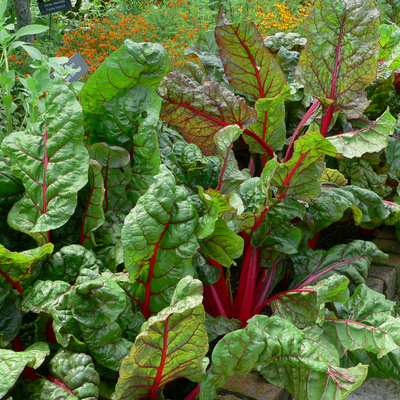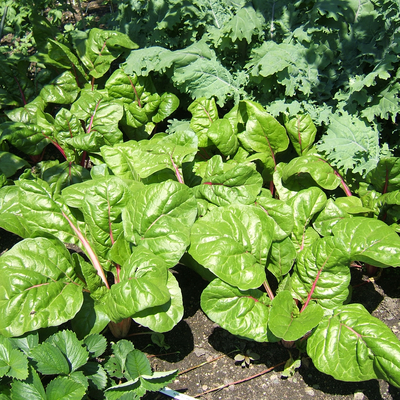A quick guide to spinach and Swiss chard
- You can direct seed both spinach and Swiss chard. You can also transplant Swiss chard.
- Spinach is day-length sensitive, while chard is not.
- Spinach and Swiss chard can grow new leaves after the first harvest, especially if you harvest individual leaves at the "baby" stage, so multiple harvests are possible.
- You can cook spinach and Swiss chard, as well as eat them raw.
Popular leafy greens
Swiss chard and spinach are leafy greens in the amaranth family, grown in many Minnesota gardens.
You can eat spinach (Spinacia oleracea) leaves raw or cooked. You can also cook and eat the “crown” of the plant, the area where all the leaves emerge at the soil surface.
Chard (Beta vulgaris) is the same species as beet, and you can use its leaves just like beet greens. While beets form a large taproot and develop a modest crop of leaves, chard grows a large crop of giant leaves and a thin, branched taproot. You can use chard leaves raw in salads, as well as cook them. The upright ruffled leaves with thick leaf stalks are attractive in the garden, with colors ranging from green and white to pink, red, orange and yellow.
While spinach is always available in grocery stores and on restaurant menus, chard is a less common vegetable. In the garden, chard is easy to grow, yielding tasty leaves from spring through fall, while spinach can be very frustrating to gardeners.
Soil pH and fertility
- Have your soil tested.
- Spinach will do best in soil with pH between 6.5 and 8. For Swiss chard, soil pH can be somewhat more acidic than soil for spinach, as low as pH 6.
- Apply phosphorus (P) and potassium (K) according to soil test recommendations.
- Many Minnesota soils have enough phosphorus. Unless your soil test report specifically recommends additional phosphorus, use a low- or no-phosphorus fertilizer.
- Improve your soil by adding well-rotted manure or compost in spring or fall. Do not use fresh manure as it may contain harmful bacteria and may increase weed problems.
- Do not use any fertilizer containing a weed killer ("Weed and Feed"), as it may kill your vegetable plants.
Selecting plants
An important difference between the two plants is that spinach is day length sensitive, while chard is not. Spinach plants respond to increasing day length by “bolting:” sending up a flowering stalk and setting seed. In hot weather, plants respond more quickly to the day length signal. Drought can also accelerate bolting.
During May, the days are much longer than the nights. If the weather turns hot, or the planting gets dry, a spinach planting will stop leaf production and grow a flowering stem. In June, the plants tend to bolt even in cool weather.
Growers breed and select spinach varieties for resistance to bolting, but Minnesota’s northern latitude means that our day length increases quickly through the spring, to the very long days of mid-June. Our long days will even challenge varieties that are slow to bolt.
Many gardeners develop a liking for Swiss chard and learn to cook with it simply because it is a reliable crop. Chard is a biennial. It will not flower until the plant has lived through a winter, so there is no danger of it bolting in summer heat.
Chard does best in cooler weather. In the summer, its growth will slow, but as long as the soil does not dry out, it will still grow leaves. When cool weather returns in September, the plants quickly develop many leaves.
A number of leafy greens can be summer substitutes for spinach: heat-loving plants that grow tender, thick leaves. These plants can fill in the gap between spinach crops, and provide harvests when chard growth has slowed due to summer heat. Follow seed packet instructions for planting.
- Malabar Spinach (Basella rubra): a vining plant that needs a trellis
- New Zealand Spinach (Tetragonia tetragonioides): texture and flavor similar to cooked spinach
- Orache (Atriplex hortensis): texture and flavor similar to cooked spinach
- Vegetable Amaranth (Amaranthus tricolor): cooked spinach flavor
Planting
To direct seed spinach for a summer crop, sow seeds as soon as the soil is workable in the spring. For a continuous spring supply, plant spinach seeds every one to two weeks, until outdoor temperatures reach 80°F. For a fall crop, sow seed two months before the average first frost date. Combine a modest harvest of spinach with other early crops such as peas, lettuce and chives for a fresh-from-the-garden meal.
Spinach planted in August for a fall crop will grow under shortening days, and will not bolt. In the cooler northeastern part of Minnesota, from Duluth north, spinach planted in early August will likely flourish. In other parts of the state, it is best to wait until mid-August or later to sow the fall crop of spinach, to avoid summer heat.
Start chard somewhat later, in early to mid-May, as cold temperatures can lead to bolting. In this case, the plant bolts because it perceives a “winter” that signals it to flower. There is no need to make multiple chard plantings, as the plants will not bolt due to heat or day length.
Plant seeds one-fourth to one-half inch deep, in rows 18 to 30 inches apart. Thin Swiss chard to four to six inches apart. Thin spinach to two to four inches apart.
Use a floating row cover to protect the seedlings from cold weather and insects. Once the weather has warmed, remove the row cover or replace it with a lightweight mesh cover, so the plants do not have exposure to too much heat. A lightweight cover will continue to protect the plants from flea beetles and leaf miners.
You can transplant Swiss chard. For summer crops, plant seed indoors in early April or about four weeks before transplanting. For fall crops, sow seed indoors in June.
Room temperature should be good for germination unless the house is particularly cool because of air conditioning. In this case, use a heating mat for faster germination.
Harden seedlings by reducing water and temperature for two to three days before transplanting. Choose an overcast day to set plants in the garden. Transplant four to six inches apart, in rows 18 to 30 inches apart. Closer spacing will result in smaller, "baby leaf" plants, and farther spacing will result in larger heads or plants.
How to keep your spinach and Swiss chard plants healthy and productive
- Chard can withstand drought-like weather, but it will not produce new leaves during dry spells, and existing leaves will not expand. The plants will start to grow again after improved soil moisture.
- For best quality, highest yield and to delay bolting in spring, make sure you provide enough water for spinach plants.
- If the planting does not receive one inch of rain each week, soak the soil thoroughly at least once a week.
- If your soil is sandy, it is important to water more often than once a week.
- An inch of water will wet a sandy soil to a depth of ten inches, a heavy clay soil to six inches.
- Use a trowel to see how far down the soil is wet. If it is only an inch or two, keep the water running.
Frequent, shallow cultivation with a hoe or other tool will kill weeds before they become a problem. Be careful not to damage the plants when cultivating.
Mulching with herbicide-free grass clippings, weed-free straw or other organic material to a depth of three to four inches can help prevent weed growth, decreasing the need for frequent cultivation.
Two common weeds in particular can be a problem in chard rows: lamb’s quarters and pigweed. They are related plants, and their seedlings look similar to beet seedlings. Both grow seedlings with reddish leaves, as do many chard varieties. Lamb’s quarters and pigweed both will start to grow a vertical stem, whereas chard plants only grow leaves from the crown of the plant, at ground level.
In spring, harvest single leaves as soon as they reach a usable size by pulling them from the plants. Spinach and Swiss chard can grow new leaves, especially if you harvest individual leaves at the "baby" stage, so multiple harvests are possible.
If you notice a spinach plant bolting, the rest will soon follow, so harvest all of them.
You can pick the fall crop leaf by leaf, or you can harvest the whole plant by cutting it off at or just above the soil surface. This later crop of spinach is likely to grow much larger leaves and crowns than a spring crop. As cold weather sets in, a floating row cover can protect the plants from freezing, giving them a chance to grow
Some gardeners harvest entire heads of chard at once rather than picking individual leaves.
Both spinach and chard will only last for a few days in the refrigerator. Harvesting when plants are cool, rather than in the heat of the day, running leaves under cold water and immediately refrigerating them, will make it possible for spinach to last a week. Chard may last slightly longer. It is best to pick these vegetables as you need them.
For a large end-of-season harvest, freezing is the best way to preserve leafy greens.
Managing pests, diseases, and disorders
Many things can affect spinach and Swiss chard. Changes in physical appearance and plant health can be caused by the environment, plant diseases, insects and wildlife. In order to address what you’re seeing, it is important to make a correct diagnosis.
You can find additional help identifying common pest problems by using the online diagnostic tools or by sending a sample to the UMN Plant Disease Diagnostic Clinic. You can use Ask a Master Gardener to share pictures and get input.
- Cutworms can cut young plants off at the base.
- Snails and slugs may cause holes in the leaves.
- Leafminers make tunnels through the flesh of the leaves, leaving transparent markings.
Cercospora leaf spot is sometimes present on Swiss chard in Minnesota. This type of leaf spot may stunt plant growth and creates reddish-purple spots on the leaves.
Spinach plants can start to flower after multiple days of high temperatures (greater than 75° F).
Reviewed in 2022




